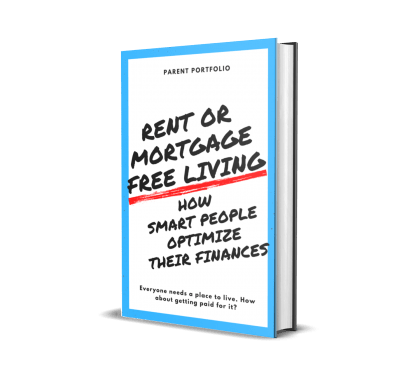Affordable Living: 13 Budget-Friendly Housing Solutions

If you’re struggling to make ends meet, finding cheaper housing alternatives could be the solution to mending your money woes. There are less expensive ways to live that don’t involve selling your worldly possessions and couch-surfing indefinitely. With a little creativity, and a willingness to simplify your life, you can find affordable, comfortable housing.
Read on to learn:
- What is considered affordable housing?
- How to find and live in cheap housing?
- How can you save money on housing?
What Is Considered Affordable Housing?
The average American spends $1,784 per month on living accommodations. A sound financial goal is to allot 30% of your gross monthly income toward your housing budget, including electricity, heat, and water.
The cost of living by state can vary tremendously, but with rents and utilities rising across the country, the suggested 30% rule can be unrealistic. In certain cities and areas with a high cost of living, housing can eat up 50% of a person’s budget, straining their ability to save and meet financial goals.
13 Cheap Housing Alternatives
When thinking about the cheapest ways to live and trying to open up some breathing room in your budget, ask yourself, “Is my housing situation affordable?” If you are living paycheck to paycheck and not saving, your living situation may have to change. Fortunately, there are a range of possibilities when it comes to seeking cheap housing.
Here are 13 housing alternatives to help cut the cost of living and bring balance to your budget.
1. Moving to a Cheaper Area
When looking for cheaper accommodations, one of the biggest moves you can make is a literal one: Move to a place with lower housing costs.
For instance, the costs of the Los Angeles housing market are typically far more than in rural Idaho. Your choice of locale can add hundreds, sometimes thousands of dollars to your monthly bill.
If your job and life situation permits, you could look for a less pricey neighborhood nearby or something more affordable that is within commuting distance of your work. If that doesn’t help make ends meet, it might be wise to consider relocation to another state where the rents are cheaper.
Unfortunately, relocating can be expensive. It can be difficult to tabulate how much money you’d need to move. Resettling in another state may involve the cost of typical moving expenses and supplies, getting a new license and vehicle registration, and typical costs.
2. Living in a Recreational Vehicle (RV)
The use of recreational vehicles surged during the pandemic, with people itching to get out of their quarantines and onto the open road. Having an RV can do more than satiate your wanderlust, it can be an affordable housing option.
While a new RV is not cheap, you can find used ones for around the price of a used car. Despite their somewhat restrictive quarters and the constant need for parking, the sense of freedom, including financial, could be worth it, especially if you’re a nature lover. While it may not be a forever move, it can give your budget a break for a while.
3. School Bus Homes
Here’s a quirky way to live more cheaply for a period of time: Get on the bus. A converted school bus is cheaper than an RV. A used school bus can run between $3,000 and $10,000 dollars.
The interior renovations are the biggest cost factor. A school bus conversion, complete with hookups for electricity and water, can cost around $30,000.
Parking can be an issue, so do your homework first on everything from national forests to a friend’s roomy property in terms of where to pull up.
Quick Money Tip: When you overdraft your checking account, you’ll likely pay a non-sufficient fund fee of, say, $35. Look into linking a savings account to your checking account as a backup to avoid that, or shop around for high interest bank account that doesn’t charge you for overdrafting.
4. Living on a Boat
Perhaps you prefer life on the water vs. life on the road. In that case, choosing a boat as your primary residence could satisfy your inner sea captain and your financial needs.
Not including the cost of a boat, maintaining your nautical lifestyle can run an average of $2,000 to $3,000 a month. But you can reduce your costs by spending more time at sea and less on marina fees. Of course, if you have a Monday-to-Friday office job, this will be a challenge. For those with flexible or work-from-home schedules, it could work.
5. Living Abroad
With the cost of living rising in America, some people are looking beyond the borders for affordable housing. Your dollar can go far in places like Vietnam, Costa Rica, and Thailand, as long as you can work and procure the proper visas.
However, establishing a permanent residency in a foreign country can be tricky, and shipping your stuff internationally can be a hefty expense. You’ll want to do the research and do the math before making a move, but it could be an option — and an adventure — for some.
6. Renting a Guest House
You can lower your housing costs by moving into a garage apartment or a mother-in-law suite in someone’s home. What you sacrifice in space and privacy can be made up in savings on rent and utilities. If a friend or acquaintance has one to let, great. Also look at the usual rental listings for options on this front.
7. Living in a Mobile Home
What else is among the cheapest ways to live? Purchasing or renting a mobile home can be way more affordable than an apartment or house. Utilities are sometimes included, but be sure to factor in the costs of the lot fees, community fees, and other charges imposed by the trailer park landlord.
8. Moving into a Tiny Home
Tiny houses have exploded in popularity, popping up on TV shows and social media feeds. The term describes compact dwellings of no more than 600 square feet or so, with many of them being just 225 square feet. If you don’t have enough of a down payment for a traditional house, a tiny home offers a more budget-friendly alternative and hip design options. The national average price for a tiny home is $52,000, a fraction of the figure for a full-sized home.
Not ready to commit to close quarters? Renting a tiny house can run between $600 and $800, still cheaper than a lot of apartment rentals. But you may have to pay for storage for all your oversized belongings.
9. Living in a Shipping Container Home
Believe it or not, one of the newest cheap ways of living can involve cutting-edge high design. Repurposing shipping containers into industrial-chic small homes has become a trend lately. These containers are way cheaper than a house and can be configured in unique ways, combining multiple containers for more square footage.
In terms of how much you’ll spend, converting a container to a livable space could cost you up to $45,000 per unit.
10. Living as a Live-In Caretaker
If you’re looking for employment as well as more affordable housing, being a live-in caregiver can be an ideal situation. You could look after an elderly or disabled individual in exchange for a free room and a monthly salary. Another option is being an au pair or nanny, which can work well if you love kids.
11. Being an On-Site Property Manager
In terms of finding cheap ways to live, you might explore becoming an on-site property manager if you’re handy. You’d be responsible for superintendent-type duties — garbage removal, cleaning common areas, and the basic upkeep of the building — in exchange for low-cost or free rent.
12. Renting Out a Room in Your Home
Here’s a way to save on housing costs that flips the script. If you are fortunate enough to have a spare room in your house or apartment and don’t mind having a roommate, renting out your extra space can cut your expenses significantly. Just be sure to properly vet the renter before agreeing to an arrangement.
13. Move in with Friends or Family
If you need to cut housing costs to the barebones (perhaps you’re trying to financially survive a layoff), think about family members or close friends who could make room for you. In some cases, you may be able to pay no rent but contribute to the household via cooking, cleaning, and other chores. While a temporary move, it can help you.
While likely a temporary move, it can give you time to break out of habits that make you bad with money and prepare to get your own place again.
The Takeaway
Housing costs can take a big bite out of your budget. If you want to save money or stop living beyond your means, reevaluating your housing situation is a great place to start.
If you are willing to be flexible, and a little unconventional, you can secure an affordable home that suits your lifestyle and your bank account.
FAQ
Is living cheaply worth it mentally?
Living cheaply and within your means can typically bring financial peace of mind and allow you to save for the future. However, if taken to an extreme, frugality can cause some people a high level of stress.
What are the hidden costs of living in affordable housing?
While affordable housing can save you money down the line, there are expenses such as down payments, first-and-last month’s rent, security deposits, and the costs of moving or storage units to consider. Also look out for broker’s fees when renting if cheap ways to live is your goal.
Are there monthly rent payments at mobile homes?
Yes, you can rent a mobile home by the month. Be sure to ask the landlord about common fees, who covers utilities, and other potential additional costs. Different properties have different policies, and you don’t want any surprises if you move in.
Disclaimers:
Financial Tips & Strategies: The tips provided on this website are of a general nature and do not take into account your specific objectives, financial situation, and needs. You should always consider their appropriateness given your own circumstances.
SoFi® Checking and Savings is offered through SoFi Bank, N.A. ©2022 SoFi Bank, N.A. All rights reserved. Member FDIC. Equal Housing Lender.
SoFi members with direct deposit can earn up to 3.75% annual percentage yield (APY) interest on Savings account balances (including Vaults) and up to 2.50% APY on Checking account balances. There is no minimum direct deposit amount required to qualify for these rates. Members without direct deposit will earn 1.20% APY on all account balances in Checking and Savings (including Vaults). Interest rates are variable and subject to change at any time. These rates are current as of 12/16/2022. Additional information can be found at http://www.sofi.com/legal/banking-rate-sheet
SOBK0822036
This article is originally on SoFi.






